ESP Lancia Ypsilon 2003 Owner handbook (in English)
[x] Cancel search | Manufacturer: LANCIA, Model Year: 2003, Model line: Ypsilon, Model: Lancia Ypsilon 2003Pages: 191, PDF Size: 2.45 MB
Page 5 of 191
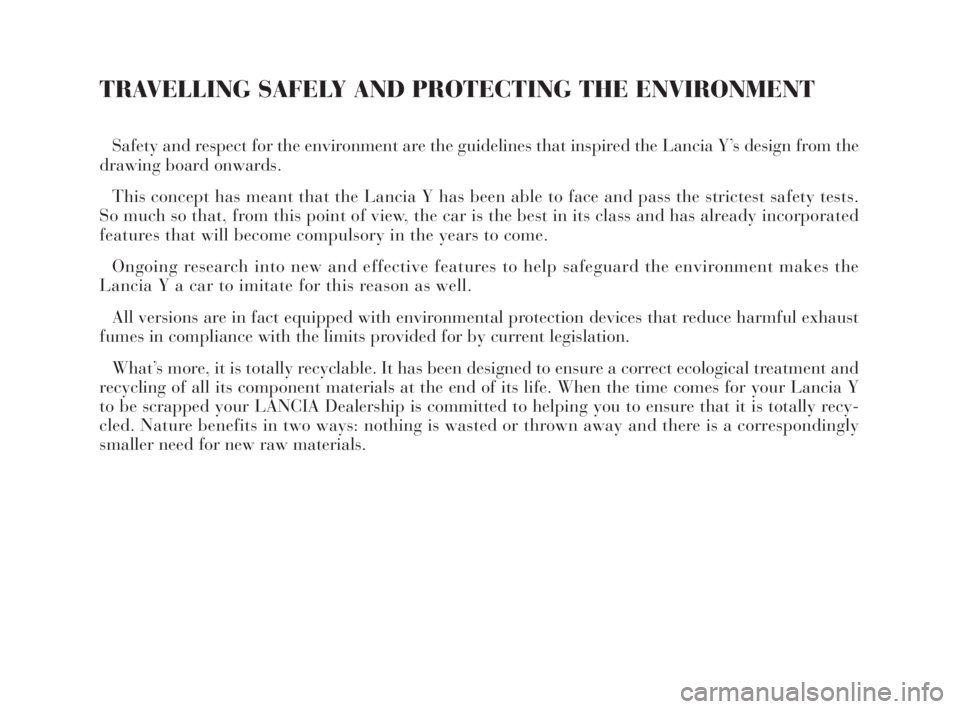
TRAVELLING SAFELY AND PROTECTING THE ENVIRONMENT
Safety and respect for the environment are the guidelines that inspired the Lancia Y’s design from the
drawing board onwards.
This concept has meant that the Lancia Y has been able to face and pass the strictest safety tests.
So much so that, from this point of view, the car is the best in its class and has already incorporated
features that will become compulsory in the years to come.
Ongoing research into new and effective features to help safeguard the environment makes the
Lancia Y a car to imitate for this reason as well.
All versions are in fact equipped with environmental protection devices that reduce harmful exhaust
fumes in compliance with the limits provided for by current legislation.
What’s more, it is totally recyclable. It has been designed to ensure a correct ecological treatment and
recycling of all its component materials at the end of its life. When the time comes for your Lancia Y
to be scrapped your LANCIA Dealership is committed to helping you to ensure that it is totally recy-
cled. Nature benefits in two ways: nothing is wasted or thrown away and there is a correspondingly
smaller need for new raw materials.
G
4C001-067 ING 11-03-2008 11:57 Pagina 2
Page 6 of 191
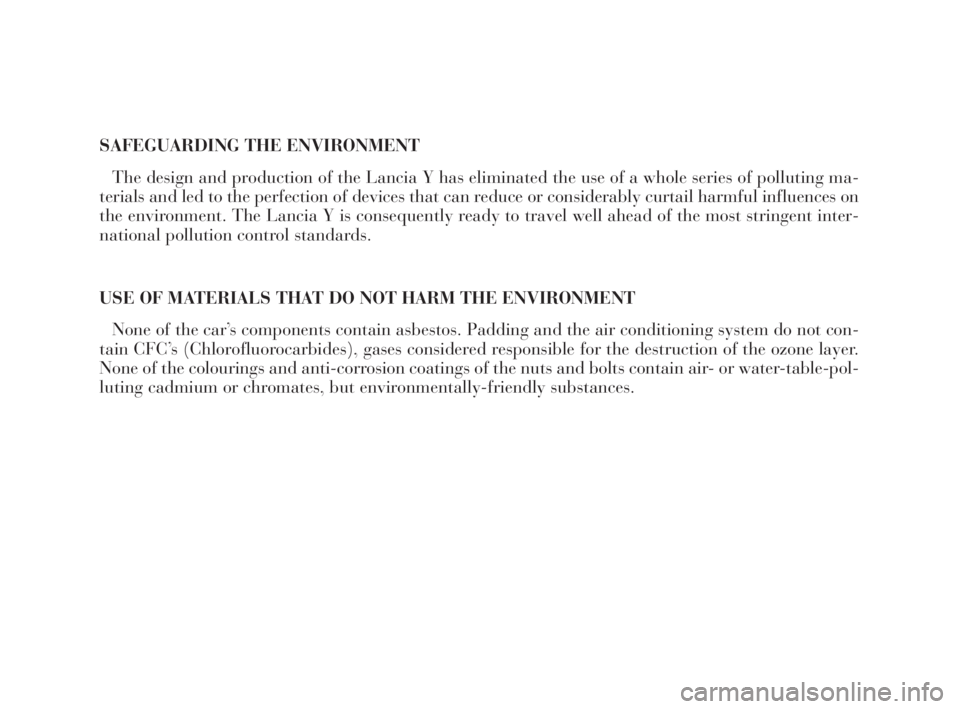
SAFEGUARDING THE ENVIRONMENT
The design and production of the Lancia Y has eliminated the use of a whole series of polluting ma-
terials and led to the perfection of devices that can reduce or considerably curtail harmful influences on
the environment. The Lancia Y is consequently ready to travel well ahead of the most stringent inter-
national pollution control standards.
USE OF MATERIALS THAT DO NOT HARM THE ENVIRONMENT
None of the car’s components contain asbestos. Padding and the air conditioning system do not con-
tain CFC’s (Chlorofluorocarbides), gases considered responsible for the destruction of the ozone layer.
None of the colourings and anti-corrosion coatings of the nuts and bolts contain air- or water-table-pol-
luting cadmium or chromates, but environmentally-friendly substances.
G
4C001-067 ING 11-03-2008 11:57 Pagina 3
Page 18 of 191

15
G
DUPLICATE KEYS
If you ask for extra keys, remember
that all the keys, both the new ones
and those you already possess, must
be stored in the memory (up to a
maximum of 7). Go directly to your
nearestLANCIA Dealership, taking
with you the burgundy “master” key,
all the keys in your possession and the
CODE card. The LANCIA Dealer-
shipmay ask you to demonstrate that
you own the car.
The codes of any keys that are not
available when the new storage pro-
cedure is carried out will be deleted
from the memory to prevent any lost
keys being used to start the car.
The burgundy key, plus
all the other keys, and the
CODE card must be
handed over to the new owner
when selling the car.Ministerial homologation
With respect to the legislation in
force in each country on the use of ra-
dio frequencies:
– the market specific homologation
codes are given in the chapter “Ac-
cessory installation”;
– the homologation code is printed
on the ignition key-remote control for
the markets which require it.DOOR LOCK/UNLOCK
REMOTE CONTROL (fig. 3)
The remote control is built into the
ignition key. It consists of a button C
and a LED D. The button operates
the control and the LED flashes while
the transmitter is sending the code to
the receiver.
This a radio-frequency remote con-
trol and must be used close to the car.
fig. 3
P4C00058
4C001-067 ING 11-03-2008 11:57 Pagina 15
Page 19 of 191
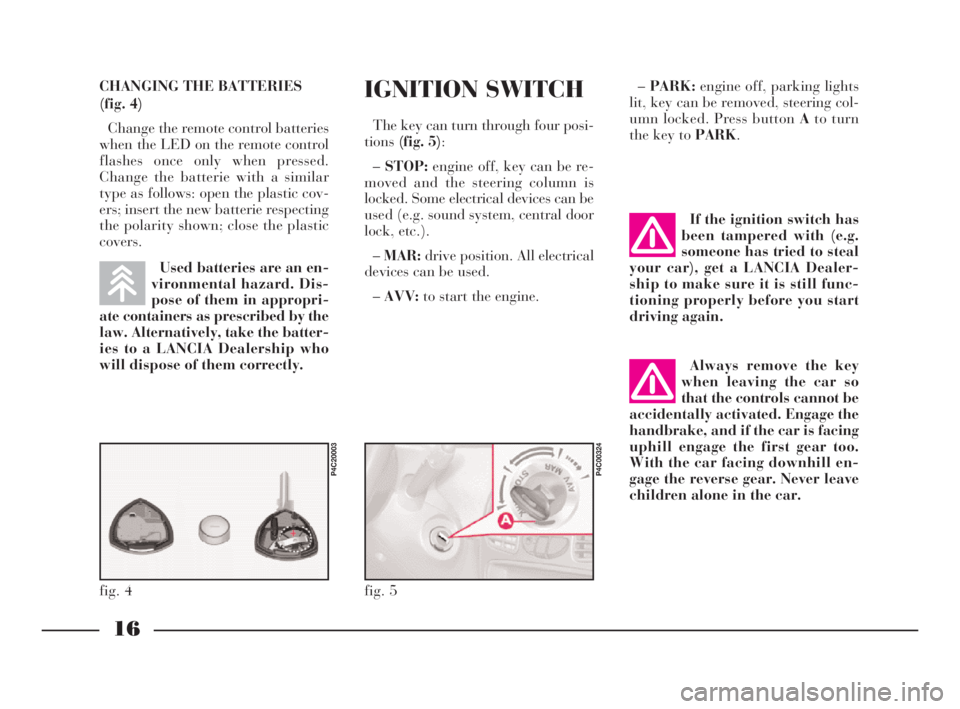
IGNITION SWITCH
The key can turn through four posi-
tions(fig. 5):
–STOP:engine off, key can be re-
moved and the steering column is
locked. Some electrical devices can be
used (e.g. sound system, central door
lock, etc.).
–MAR:drive position. All electrical
devices can be used.
–AVV:to start the engine.–PARK:engine off, parking lights
lit, key can be removed, steering col-
umn locked. Press button Ato turn
the key to PARK.
fig. 5
P4C00324
If the ignition switch has
been tampered with (e.g.
someone has tried to steal
your car), get a LANCIA Dealer-
ship to make sure it is still func-
tioning properly before you start
driving again.
Always remove the key
when leaving the car so
that the controls cannot be
accidentally activated. Engage the
handbrake, and if the car is facing
uphill engage the first gear too.
With the car facing downhill en-
gage the reverse gear. Never leave
children alone in the car.
16
G
CHANGING THE BATTERIES
(fig. 4)
Change the remote control batteries
when the LED on the remote control
flashes once only when pressed.
Change the batterie with a similar
type as follows: open the plastic cov-
ers; insert the new batterie respecting
the polarity shown; close the plastic
covers.
Used batteries are an en-
vironmental hazard. Dis-
pose of them in appropri-
ate containers as prescribed by the
law. Alternatively, take the batter-
ies to a LANCIA Dealership who
will dispose of them correctly.
fig. 4
P4C20003
4C001-067 ING 11-03-2008 11:57 Pagina 16
Page 27 of 191
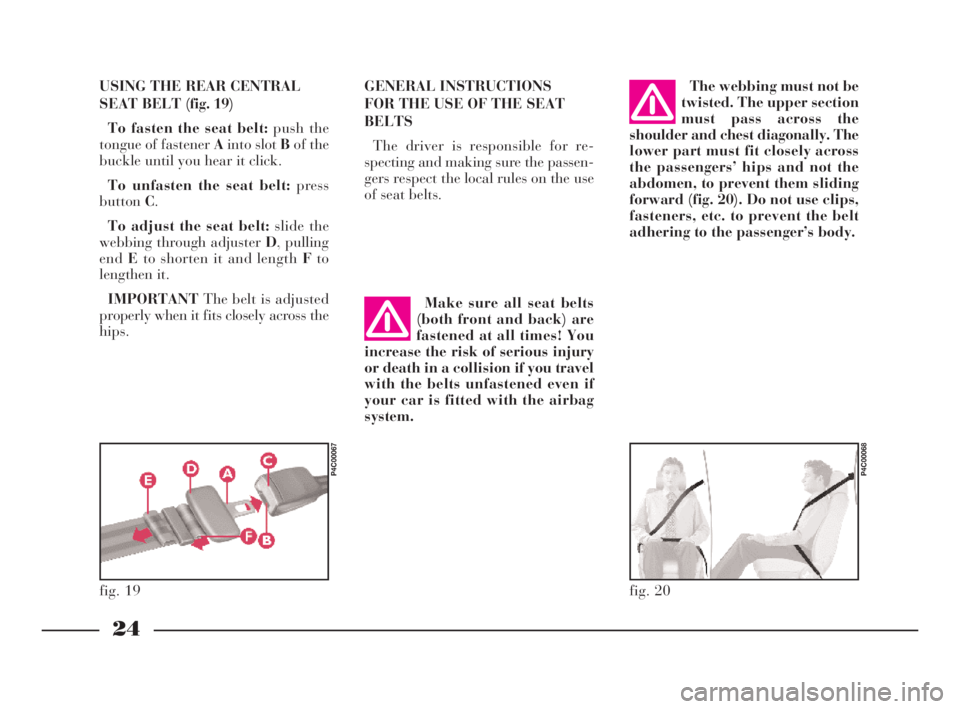
24
G
The webbing must not be
twisted. The upper section
must pass across the
shoulder and chest diagonally. The
lower part must fit closely across
the passengers’ hips and not the
abdomen, to prevent them sliding
forward (fig. 20). Do not use clips,
fasteners, etc. to prevent the belt
adhering to the passenger’s body.
Make sure all seat belts
(both front and back) are
fastened at all times! You
increase the risk of serious injury
or death in a collision if you travel
with the belts unfastened even if
your car is fitted with the airbag
system.
fig. 20
P4C00068
GENERAL INSTRUCTIONS
FOR THE USE OF THE SEAT
BELTS
The driver is responsible for re-
specting and making sure the passen-
gers respect the local rules on the use
of seat belts. USING THE REAR CENTRAL
SEAT BELT(fig. 19)
To fasten the seat belt: push the
tongue of fastener Ainto slot Bof the
buckle until you hear it click.
To unfasten the seat belt: press
buttonC.
To adjust the seat belt: slide the
webbing through adjuster D, pulling
endEto shorten it and length Fto
lengthen it.
IMPORTANTThe belt is adjusted
properly when it fits closely across the
hips.
fig. 19
P4C00067
4C001-067 ING 11-03-2008 11:57 Pagina 24
Page 29 of 191
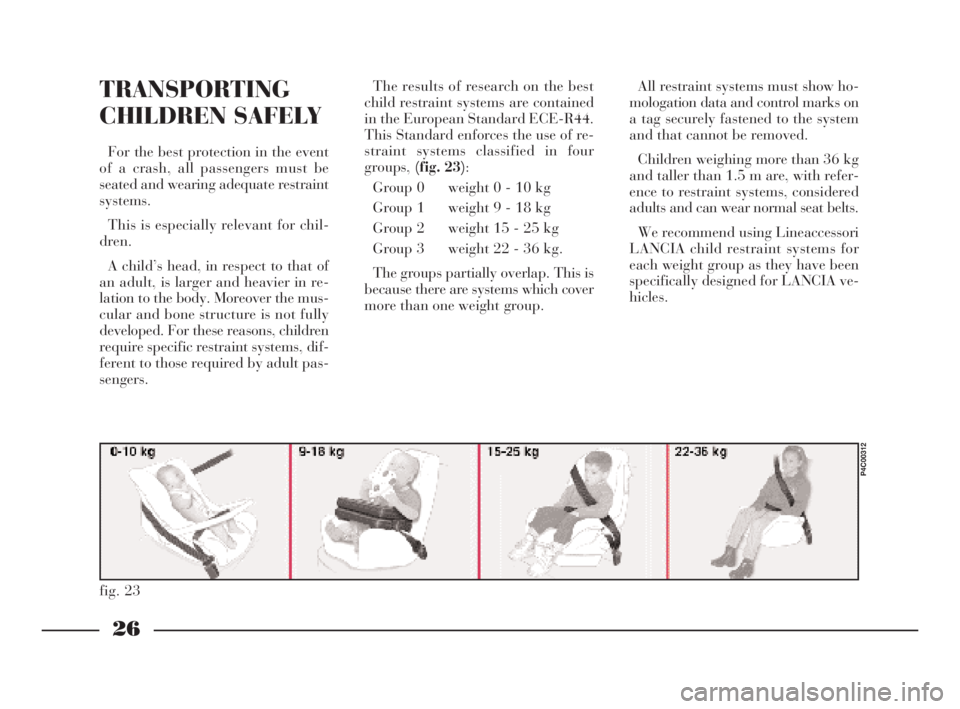
26
G
fig. 23
P4C00312
TRANSPORTING
CHILDREN SAFELY
For the best protection in the event
of a crash, all passengers must be
seated and wearing adequate restraint
systems.
This is especially relevant for chil-
dren.
A child’s head, in respect to that of
an adult, is larger and heavier in re-
lation to the body. Moreover the mus-
cular and bone structure is not fully
developed. For these reasons, children
require specific restraint systems, dif-
ferent to those required by adult pas-
sengers.The results of research on the best
child restraint systems are contained
in the European Standard ECE-R44.
This Standard enforces the use of re-
straint systems classified in four
groups,(fig. 23):
Group 0 weight 0 - 10 kg
Group 1 weight 9 - 18 kg
Group 2 weight 15 - 25 kg
Group 3 weight 22 - 36 kg.
The groups partially overlap. This is
because there are systems which cover
more than one weight group.All restraint systems must show ho-
mologation data and control marks on
a tag securely fastened to the system
and that cannot be removed.
Children weighing more than 36 kg
and taller than 1.5 m are, with refer-
ence to restraint systems, considered
adults and can wear normal seat belts.
We recommend using Lineaccessori
LANCIA child restraint systems for
each weight group as they have been
specifically designed for LANCIA ve-
hicles.
4C001-067 ING 11-03-2008 11:57 Pagina 26
Page 42 of 191
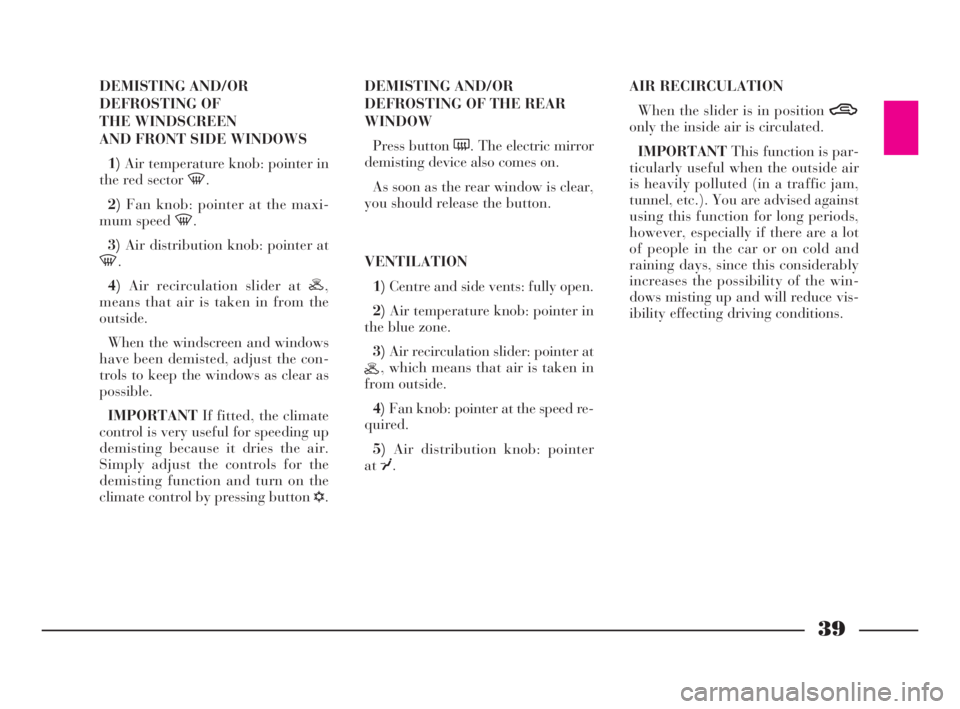
39
G
DEMISTING AND/OR
DEFROSTING OF
THE WINDSCREEN
AND FRONT SIDE WINDOWS
1)Air temperature knob: pointer in
the red sector -.
2)Fan knob: pointer at the maxi-
mum speed -.
3)Air distribution knob: pointer at
-.
4)Air recirculation slider at H,
means that air is taken in from the
outside.
When the windscreen and windows
have been demisted, adjust the con-
trols to keep the windows as clear as
possible.
IMPORTANTIf fitted, the climate
control is very useful for speeding up
demisting because it dries the air.
Simply adjust the controls for the
demisting function and turn on the
climate control by pressing button
√.DEMISTING AND/OR
DEFROSTING OF THE REAR
WINDOW
Press button (. The electric mirror
demisting device also comes on.
As soon as the rear window is clear,
you should release the button.
VENTILATION
1)Centre and side vents: fully open.
2)Air temperature knob: pointer in
the blue zone.
3)Air recirculation slider: pointer at
H, which means that air is taken in
from outside.
4)Fan knob: pointer at the speed re-
quired.
5)Air distribution knob: pointer
at¥.AIR RECIRCULATION
When the slider is in position T
only the inside air is circulated.
IMPORTANTThis function is par-
ticularly useful when the outside air
is heavily polluted (in a traffic jam,
tunnel, etc.). You are advised against
using this function for long periods,
however, especially if there are a lot
of people in the car or on cold and
raining days, since this considerably
increases the possibility of the win-
dows misting up and will reduce vis-
ibility effecting driving conditions.
4C001-067 ING 11-03-2008 11:57 Pagina 39
Page 43 of 191

40
G
CLIMATE CONTROL
SYSTEM
The climate control system is ad-
justed manually.
CONTROLS (fig. 45)
A- Air temperature knob (mixture
of warm and cold air).
B- Fan knob.
C- Air distribution knob.
D- Air recirculation slider, to elim-
inate external air.IMPORTANTThe recirculation
function allows to cool the air faster.
It is particularly useful when the out-
side air is heavily polluted (in a traf-
fic jam, tunnel, etc.). You are advised
against using this function for long
periods, however, especially if there
are a lot of people in the car or on
cold and raining days, since this con-
siderably increases the possibility of
the windows misting up and will re-
duce visibility effecting driving con-
ditions.
E- Climate control on/off switch.
When the climate control system is
on, the fan will automatically come on
at the first speed.COOLING
1)Air temperature knob: pointer in
the blue sector.
2)Climate control system: press
switch
√and move the air recircula-
tion slider to T.
3)Fan knob: pointer at required
speed.
4)Air distribution knob: pointer at
¥.
To reduce the cooling effect: move
the air recirculation slider to H, in-
crease the temperature and decrease
the fan speed.
fig. 45
P4C00326
The system uses R134a
refrigerating liquid. If it
accidentally leaks it will
not damage the environment.
Never use R12 fluid as it is incom-
patible with the system’s compo-
nents and also contains CFC.
4C001-067 ING 11-03-2008 11:57 Pagina 40
Page 55 of 191

52
G
4)Fold the seat back forwards to
make a flat loading surface with the
boot floor (fig. 78).
If necessary, the cushion can also be
tilted(fig. 79). Consequently, before
releasing the seat back, lift the cush-
ion as shown and tip it against the
front seat backs; the rear seat back-
rest can then be released and tilted
forwards.
To return the seat to its normal po-
sition:
1)Return the seat back to the verti-
cal position and make sure it is prop-
erly locked into place; the red strip on
the hook-up button must disappear.
fig. 77
P4C00034
Removing the parcel shelf
If you wish to remove the parcel
shelf to extend the boot capacity, un-
hook the two tie-rods (one each side)
A (fig. 75)from the hooks B, then
pull the parcel shelf outwards so that
pinsCcome out.
The shelf can then be positioned be-
hind the front seats.INCREASING THE LOAD AREA
Proceed as follows:
1)Make sure that the side seat belts
A (fig. 76)have been inserted into the
corresponding bracket B.
2)Remove the rear head restraints
if required.
3)Release the seat back by pressing
buttonA (fig. 77)(one for each side)
located on the back seat back-rest
(even when a split back seat is fitted);
a red strip will appear on the short
side of the button (towards the inside
of the car) to indicate that it has been
released.
fig. 75
P4C00009
fig. 76
P4C00052
Heavy loads which are
not securely anchored
could seriously injure pas-
sengers in the event of an accident.
4C001-067 ING 11-03-2008 11:57 Pagina 52
Page 60 of 191

57
G
In the case of failure, although the
anti-locking system is no longer avail-
able, the car braking capacity is not
interfered with.
If you have never driven a car with
ABS it is advised to familiarise by
making a few preliminary trials on
slippery ground, obviously maintain-
ing safety conditions and respecting
the Highway Code of the country
where you are travelling. Before start-
ing, read carefully the notes below.
The advantage of ABS as compared
with the traditional system is that it
permits maximum manoeuvrability
even when pressing the brakes right
down on roads with poor grip, pre-
venting the wheels from locking.
However, this does not mean that
with ABS the braking distance is al-
ways reduced. For example, on soft
gravel surfaces or fresh snow on a
slippery surface the distance could in-
crease.In order to get the best out of the
anti-lock system when necessary, fol-
low these hints.
If the ABS triggers it
means that the car is
reaching the limit of ad-
herence between the tyres and the
road surface. Slow down to adapt
the speed to the road grip.
ABS exploits the avail-
able grip, but it is not able
to increase it. Therefore
drive carefully on slippery surfaces
and do not take undue risks.
If there is a system fail-
ure, indicated by warning
light>lighting up on the
instrument panel, drive slowly and
go immediately to a LANCIA Deal-
ership to have the system checked.
When braking round a bend be very
careful, even with the aid of ABS.
However, the most important advice
is the following:
When the ABS switches
on and you feel the pedal
throbbing, no not lighten
the pressure, but keep the pedal
pressed well down and do not
worry. In this way you will be able
to stop within the minimum dis-
tance possible, according to the
road surface.
Following these instructions you will
be always have the best braking con-
ditions.
4C001-067 ING 11-03-2008 11:57 Pagina 57